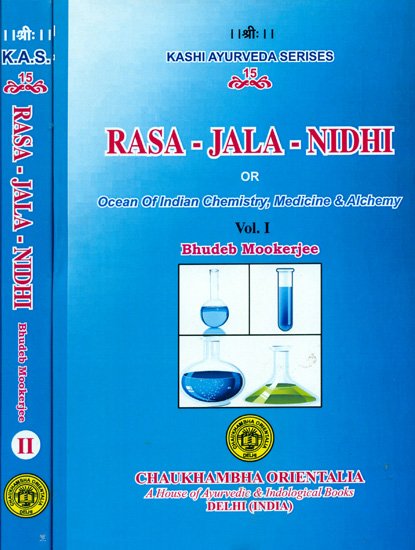Rasa Jala Nidhi, vol 4: Iatrochemistry
by Bhudeb Mookerjee | 1938 | 52,258 words | ISBN-10: 8170305829 | ISBN-13: 9788170305828
This fourth volume of the Rasa-jala-nidhi deals with Rasa-chikitsa-vidya, also known a the science of Iatrchemistry (chemical medicine), a major branch of Ayurveda. It contains Ayurvedic treatments for Fever and Diarrhea. The Rasa-jala-nidhi (“the ocean of Iatrochemistry, or, chemical medicine) is a compendium of Sanskrit verses dealing with ancie...
Treatment for fever (46): Baidya-natha rasa
One fourth tola in weight of mercury and sulphur, each, are to be rubbed well, and reduced to kajjali or black powder. Mix one tola of powdered katuki with it. It is then to be subjected to bhavana for three times with the juice of black jira or triphala, and made into pills, two raktis in weight, each. It is to be taken with the juice of leaves of black jira, or of betel leaves, and a little of hot water. Having regard to the nature of the doshas, one, two, three or four in number of such pills may be given a day. It cures all sorts of colic, nava-jvara, anemia, aversion to food, and dropsy. In case the taking of the medicine is followed by too much of the movement of the bowels, the patient is to be allowed to take boiled rice (or paste prepared from it), mixed with curd.
Conclusion:
 This concludes ‘Treatment for fever (46): Baidya-natha rasa’ included in Bhudeb Mookerjee Rasa Jala Nidhi, vol 4: Initiation, Mercury and Laboratory. The text includes treatments, recipes and remedies and is categorised as Rasa Shastra: an important branch of Ayurveda that specialises in medicinal/ herbal chemistry, alchemy and mineralogy, for the purpose of prolonging and preserving life.
This concludes ‘Treatment for fever (46): Baidya-natha rasa’ included in Bhudeb Mookerjee Rasa Jala Nidhi, vol 4: Initiation, Mercury and Laboratory. The text includes treatments, recipes and remedies and is categorised as Rasa Shastra: an important branch of Ayurveda that specialises in medicinal/ herbal chemistry, alchemy and mineralogy, for the purpose of prolonging and preserving life.
